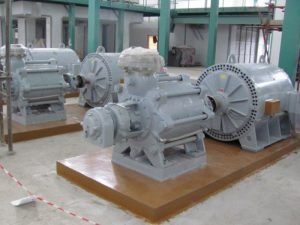NPSH in condensate pumps

Condensate pumps by Sigma Group in Mochovce nuclear plant in Slovakia[/caption]
Condensate pumps are only required for condensing type steam turbines in which steam exits the steam turbine at vacuum condition and condenses into water in the surface condenser. Condensate pumps are used to circulate the condensed steam (condensate) back to the deaerator tank. For large condensing steam turbine systems, condensate pumps are usually overhung centrifugal type. Although those condensate pumps might not necessarily comply with API 610 requirements, they should be ISO compliant. The condensate pumps are usually designed in 2x 100% configuration in which one pump is operating while the other one is on stand-by mode to ensure the required level of availability of the steam turbine system. Condensate pumps are designed to operate at a fixed flow rate. It is recommended to have the rated flow condition for the pumps at 120% of the normal operating flow to cater for off case conditions.
The major issue that need to be well considered for the condensate pumps is the Net Positive Suction Head (NPSH). The NPSH margin between the available NPSH and the required NPSH shall be maintained to eliminate the risky levels of cavitation (bubbles inception and bubbles collapse in the fluid) in the pump that may adversely affect the impeller’s blades deterioration. Because cavitation is more critical for water services and at lower temperature, NPSH margin shall be kept at according to the guidelines mentioned in the Hydraulic Institute 9.6.1.
Condensate pumps are always located below the condenser to ensure the NPSH margin is met. The NPSH available is mediated by the relative location (elevation distance) between the impeller level and the condensate low level in hot well of the condenser. Minimum Elevation to maintain NPSH Margin). The relative location of the condensate pump is constrained by the elevation between decks. The condensate level in the hot well of the condenser is affected by the system dynamics, including the steam turbine percentage of full power. While the NPSH required is mandated by the pump design and rotational speed of the impeller (eye).
The proper selection of impeller material with higher cavitation erosion resistance ensures longer life of the impeller. Hard coating of impellers of condensate pumps might be a technical solution for higher cavitation erosion resistivity. Stainless steel impellers are considered suitable for condensate pumps applications; however, the cavitation erosion resistivity varies with the grade of the stainless steel used. Parallel operation of condensate pumps shall be avoided because the system curves are designed for one pump operating at a time. Accordingly, the controls shall ensure that if one pump is operating the other shall be stopped and put in stand-by mode.
The NPSH margin for the condensate pumps shall be statically maintained by the relative position of the condensate pump with respect to the condenser, and dynamically maintained by the condensate level in the hot well of the condenser. Once the condensate level in the condenser reaches a critically low level, the condensate pump will start to enter a cavitation level which will damage the impellers, this is why a trip signal is sent to the condensate pump when the low low level condition at the hot well is reached. Also condensate pumps usually have an inhibit-to-start if the condensate level in the hot well is below the low low level. Accordingly, the level in the hot well shall be controlled using flow control valve to maintain the condensate level within two thresholds; low and high. The high level of condensate may also indicate a mal-function in the condensate pump, which triggers the trip of the operating pump and the start of the stand-by pump to reduce the level back to normal.